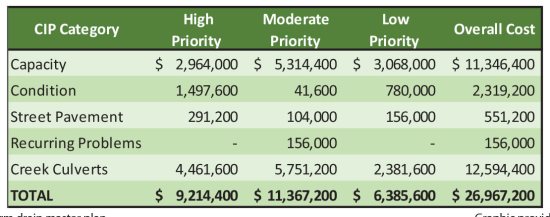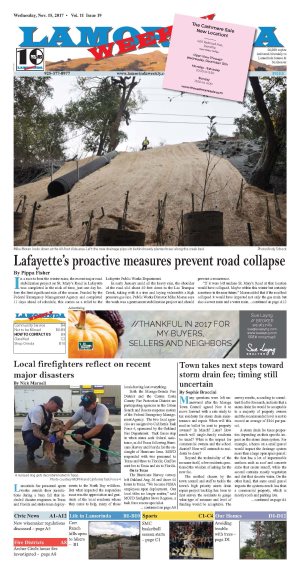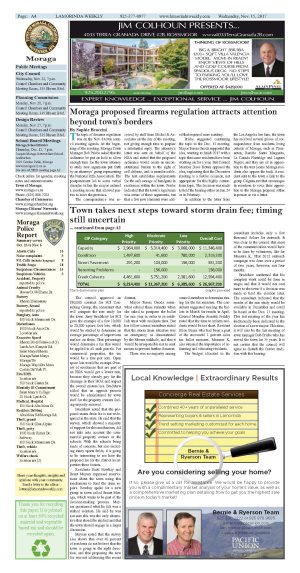| | Published November 15th, 2017
| Town takes next steps toward storm drain fee; timing still uncertain
| | | By Sophie Braccini |  | | Storm drain master plan Graphic provided |
Many questions were left unanswered after the Moraga Town Council agreed Nov. 8 to move forward with a rate study to tax residents for storm drain maintenance and repair. When will this mail-in ballot be sent to property owners? In March? Later? How much will single-family residents be taxed? What is the impact for commercial owners and the school district? How will outreach to residents be done?
 Beyond the technicality of the measure itself, a few residents questioned the wisdom of asking for the new fee.
Beyond the technicality of the measure itself, a few residents questioned the wisdom of asking for the new fee.
 The method chosen by the town council and staff to tackle the town's high priority storm drain repair project backlog has been to first survey the residents to gauge what type of measure and level of funding would be acceptable. The survey results, according to consultant Godbe Research, indicate that a storm drain fee would be acceptable to a majority of property owners and the recommended level is not to exceed an average of $144 per parcel.
The method chosen by the town council and staff to tackle the town's high priority storm drain repair project backlog has been to first survey the residents to gauge what type of measure and level of funding would be acceptable. The survey results, according to consultant Godbe Research, indicate that a storm drain fee would be acceptable to a majority of property owners and the recommended level is not to exceed an average of $144 per parcel.
 A storm drain fee taxes properties depending on their specific impact on the storm drain system. For example, a home on a small parcel would impact the drainage system more than a large open space parcel: the first has a lot of impermeable surfaces such as roof and concrete slabs that create runoff, while the second contains mostly vegetation and dirt that absorbs water. On the other hand, that same small parcel impacts the systems much less than a commercial property, which is mostly roofs and parking lots.
A storm drain fee taxes properties depending on their specific impact on the storm drain system. For example, a home on a small parcel would impact the drainage system more than a large open space parcel: the first has a lot of impermeable surfaces such as roof and concrete slabs that create runoff, while the second contains mostly vegetation and dirt that absorbs water. On the other hand, that same small parcel impacts the systems much less than a commercial property, which is mostly roofs and parking lots.
 The council approved an $80,000 contract for SCI Consulting Group, the consultant that will compute the rate study for the town. Jerry Bradshaw for SCI gave the example of a few 10,000 to 20,000 square foot lots, which would be studied to determine an average percentage of impervious surface on them. That percentage would determine a fee that would be applied to all such parcels. For commercial properties, the tax would be a rate per acre. Open space lots would be exempt. Owners of residences that are part of an HOA would get a lower rate, because they already pay for the drainage in their HOA and impact the overall system less. Bradshaw added that an appeals process would be administered by town staff for the property owners feeling unjustly assessed.
The council approved an $80,000 contract for SCI Consulting Group, the consultant that will compute the rate study for the town. Jerry Bradshaw for SCI gave the example of a few 10,000 to 20,000 square foot lots, which would be studied to determine an average percentage of impervious surface on them. That percentage would determine a fee that would be applied to all such parcels. For commercial properties, the tax would be a rate per acre. Open space lots would be exempt. Owners of residences that are part of an HOA would get a lower rate, because they already pay for the drainage in their HOA and impact the overall system less. Bradshaw added that an appeals process would be administered by town staff for the property owners feeling unjustly assessed.
 Bradshaw noted that the proposed storm drain fee is not widespread in the state. He said that the survey, which showed a majority of support for this mechanism, did not take into account the commercial property owners or the schools. With the schools being made of concrete, but also including many sports fields, it is going to be interesting to see how the proposed fee for the district incorporates these factors.
Bradshaw noted that the proposed storm drain fee is not widespread in the state. He said that the survey, which showed a majority of support for this mechanism, did not take into account the commercial property owners or the schools. With the schools being made of concrete, but also including many sports fields, it is going to be interesting to see how the proposed fee for the district incorporates these factors.
 Residents Scott Bowhay and Brent Meyers expressed reservations about the town using this mechanism to fund the drain repairs. Bowhay spoke for a new group in town called Smart Moraga, which wants to be part of the decision-making process. Meyers questioned what he felt was a rushed solution. He said he was not sure this was the only alternative that should be studied and that the town should engage in a larger discussion.
Residents Scott Bowhay and Brent Meyers expressed reservations about the town using this mechanism to fund the drain repairs. Bowhay spoke for a new group in town called Smart Moraga, which wants to be part of the decision-making process. Meyers questioned what he felt was a rushed solution. He said he was not sure this was the only alternative that should be studied and that the town should engage in a larger discussion.
 Meyers noted that the survey also shows that over 40 percent of residents do not believe that the town is going in the right direction, and that proposing the new fee was not addressing this recent distrust.
Meyers noted that the survey also shows that over 40 percent of residents do not believe that the town is going in the right direction, and that proposing the new fee was not addressing this recent distrust.
 Mayor Teresa Onoda somewhat echoed these remarks when she asked to postpone the ballot for one year in order to re-establish trust with residents first. But her fellow council members stated that the storm drain situation was an emergency, as demonstrated by the Rheem sinkhole, and that it would be irresponsible not to seek means to prevent further disasters.
Mayor Teresa Onoda somewhat echoed these remarks when she asked to postpone the ballot for one year in order to re-establish trust with residents first. But her fellow council members stated that the storm drain situation was an emergency, as demonstrated by the Rheem sinkhole, and that it would be irresponsible not to seek means to prevent further disasters.
 There was no majority among council members to determine timing for the tax measure. The consultant suggested mailing the ballots in March for results in April. Council Member Jeanette Fritzky noted that the time to inform residents would be too short. Resident Ellen Beans who had been a part of the successful 1 percent sales tax ballot measure, Measure K, also stressed the importance of informing and educating residents.
There was no majority among council members to determine timing for the tax measure. The consultant suggested mailing the ballots in March for results in April. Council Member Jeanette Fritzky noted that the time to inform residents would be too short. Resident Ellen Beans who had been a part of the successful 1 percent sales tax ballot measure, Measure K, also stressed the importance of informing and educating residents.
 The budget allocated to the consultant includes only a few thousand dollars for outreach. It was clear to the council that most of the communication would have to be done by volunteers, like for Measure K. That 2012 outreach campaign was done over a period of two years, however, not four months.
The budget allocated to the consultant includes only a few thousand dollars for outreach. It was clear to the council that most of the communication would have to be done by volunteers, like for Measure K. That 2012 outreach campaign was done over a period of two years, however, not four months.
 Bradshaw confirmed that his complete work could be done in stages and that it would not cost more to the town if a decision was made to hold the election later. The consultant indicated that the results of the rate study would be available in December and could be heard at the Dec. 13 meeting. This last meeting of the year has traditionally been dedicated to the election of a new mayor. This time, it will also be the last meeting of town manager Bob Priebe who has served the town for 35 years. It is not certain that the council will agree to disturb the festive tradition with this hearing.
Bradshaw confirmed that his complete work could be done in stages and that it would not cost more to the town if a decision was made to hold the election later. The consultant indicated that the results of the rate study would be available in December and could be heard at the Dec. 13 meeting. This last meeting of the year has traditionally been dedicated to the election of a new mayor. This time, it will also be the last meeting of town manager Bob Priebe who has served the town for 35 years. It is not certain that the council will agree to disturb the festive tradition with this hearing.


|
| | | | | | | | | | | | |




